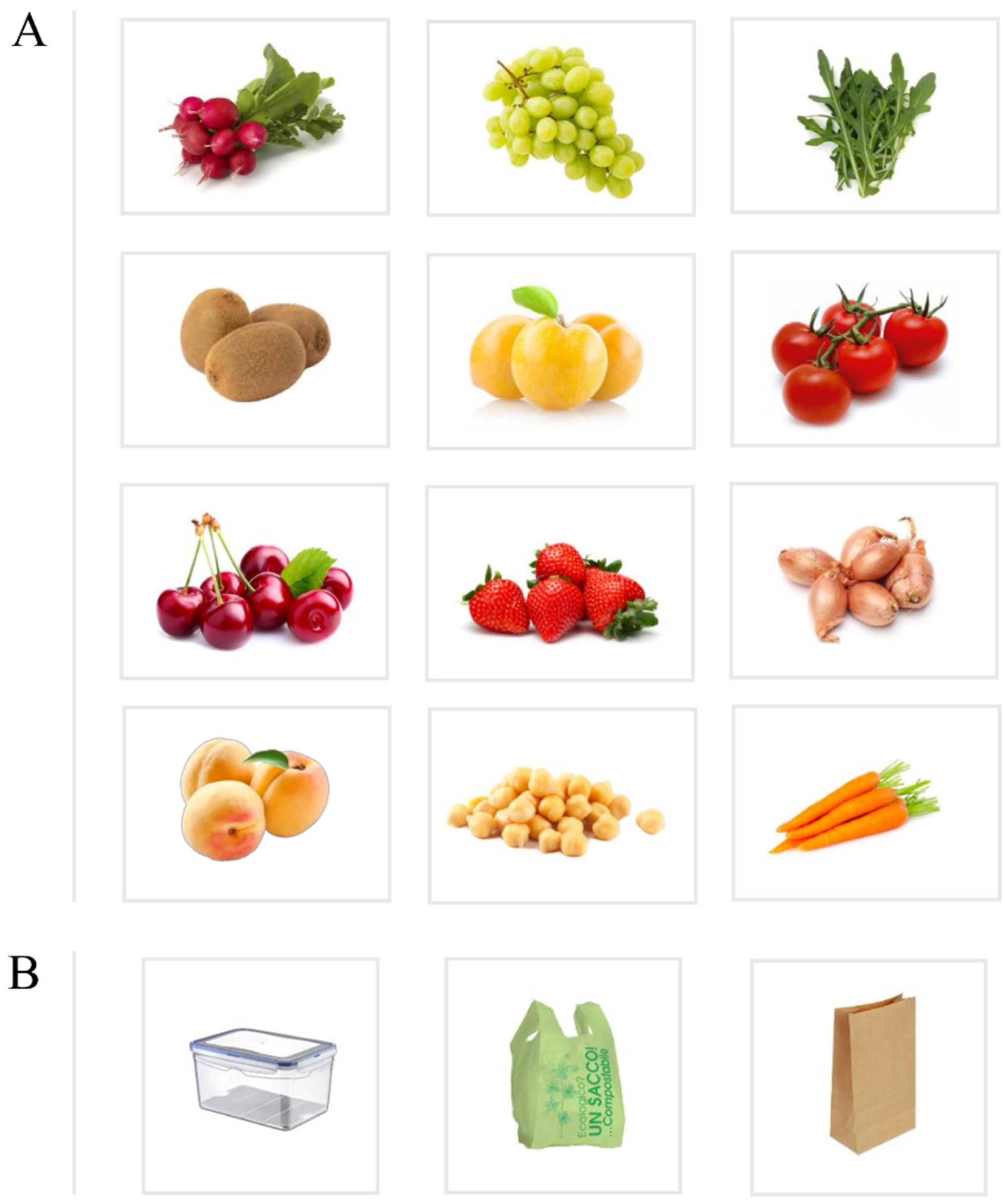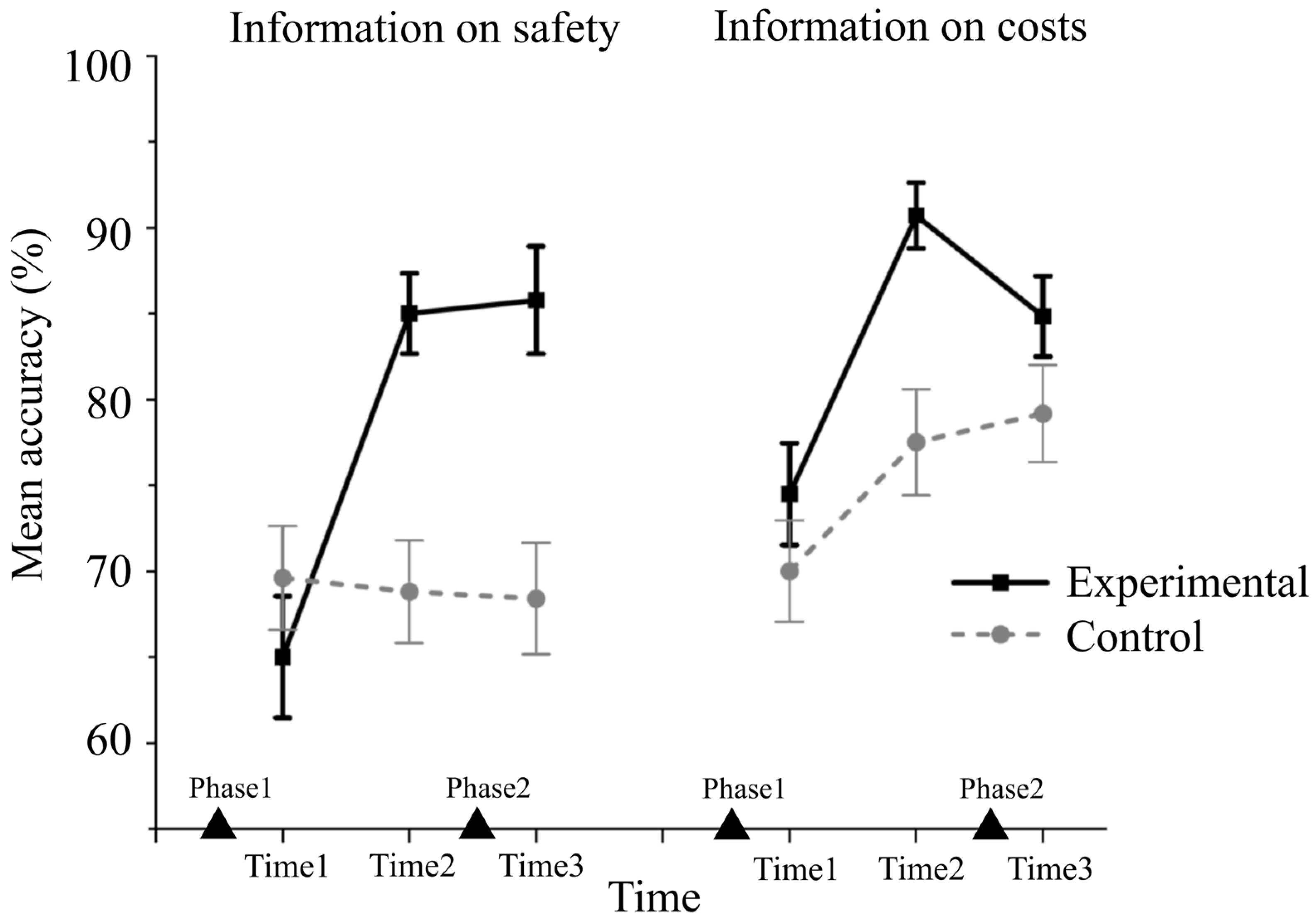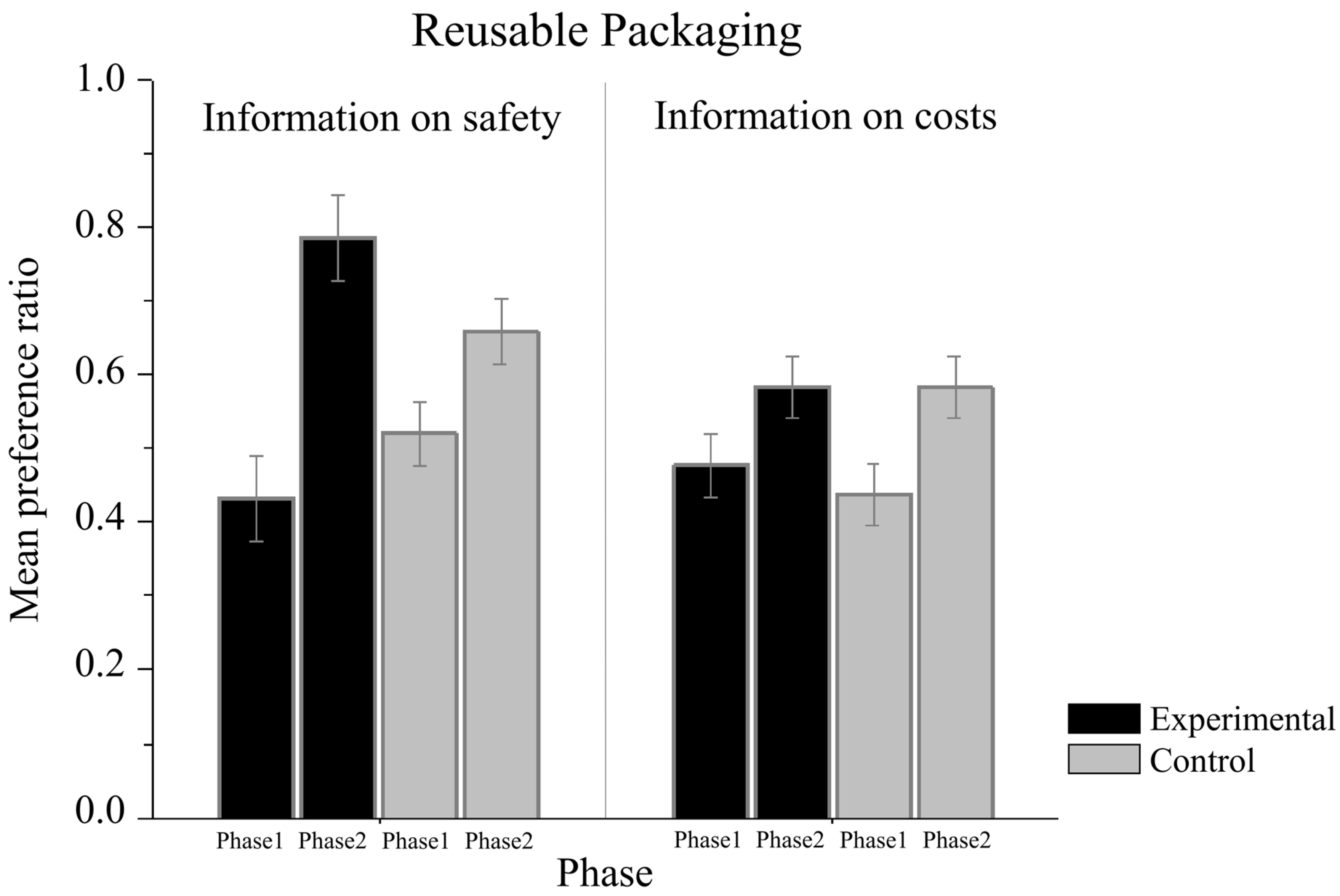Switching to Reuse: The Impact of Information on Consumers’ Choices for Reusable Food Packaging
Abstract
1. Introduction
2. Materials and Methods
2.1. Participants
2.2. Stimuli
2.3. Online Survey Design and Procedure
2.4. Data Analysis
3. Results
3.1. Manipulation Check: Information Acquisition
3.2. Main Task
3.2.1. Preferences toward Sustainable Packaging
3.2.2. Willingness to Pay
3.2.3. Motivation for Paying for Sustainable Packaging
4. Discussion
5. Conclusions
Supplementary Materials
Author Contributions
Funding
Institutional Review Board Statement
Informed Consent Statement
Data Availability Statement
Conflicts of Interest
References
- Ritchie, H.; Rosado, P.; Roser, M. Environmental Impacts of Food Production. Our World in Data. 2022. Available online: https://ourworldindata.org/environmental-impacts-of-food (accessed on 24 April 2021).
- United Nations. 2030 Agenda for Sustainable Development; United Nations: New York, NY, USA, 2015. [Google Scholar]
- Lamine, C.; Marsden, T. Unfolding Sustainability Transitions in Food Systems: Insights from UK and French Trajectories. Proc. Natl. Acad. Sci. USA 2023, 120, e2206231120. [Google Scholar] [CrossRef] [PubMed]
- Vermeir, I.; Weijters, B.; De Houwer, J.; Geuens, M.; Slabbinck, H.; Spruyt, A.; Van Kerckhove, A.; Van Lippevelde, W.; De Steur, H.; Verbeke, W. Environmentally Sustainable Food Consumption: A Review and Research Agenda from a Goal-Directed Perspective. Front. Psychol. 2020, 11, 1603. [Google Scholar] [CrossRef]
- Coussy, H.; Guillard, V.; Guillaume, C.; Gontard, N. Role of Packaging in the Smorgasbord of Action for Sustainable Food Consumption. Agro-Food-Ind. Hi Tech 2013, 24, 15–19. [Google Scholar]
- Licciardello, F. Packaging, Blessing in Disguise. Review on Its Diverse Contribution to Food Sustainability. Trends Food Sci. Technol. 2017, 65, 32–39. [Google Scholar] [CrossRef]
- Guillard, V.; Gaucel, S.; Fornaciari, C.; Angellier-Coussy, H.; Buche, P.; Gontard, N. The next Generation of Sustainable Food Packaging to Preserve Our Environment in a Circular Economy Context. Front. Nutr. 2018, 5, 121. [Google Scholar] [CrossRef] [PubMed]
- Rundh, B. Linking Packaging to Marketing: How Packaging Is Influencing the Marketing Strategy. Br. Food J. 2013, 115, 1547–1563. [Google Scholar] [CrossRef]
- ISO 18603; Packaging and the Environment—Reuse. International Organization for Standardization: Geneva, Switzerland, 2013. Available online: https://www.iso.org/obp/ui/#iso:std:iso:18603:ed-1:v1:en (accessed on 12 February 2023).
- Greenwood, S.C.; Walker, S.; Baird, H.M.; Parsons, R.; Mehl, S.; Webb, T.L.; Slark, A.T.; Ryan, A.J.; Rothman, R.H. Many Happy Returns: Combining Insights from the Environmental and Behavioural Sciences to Understand What Is Required to Make Reusable Packaging Mainstream. Sustain. Prod. Consum. 2021, 27, 1688–1702. [Google Scholar] [CrossRef]
- Miao, X.; Magnier, L.; Mugge, R. Switching to Reuse? An Exploration of Consumers’ Perceptions and Behaviour towards Reusable Packaging Systems. Resour. Conserv. Recycl. 2023, 193, 106972. [Google Scholar] [CrossRef]
- Coelho, P.M.; Corona, B.; ten Klooster, R.; Worrell, E. Sustainability of Reusable Packaging—Current Situation and Trends. Resour. Conserv. Recycl. X 2020, 6, 100037. [Google Scholar] [CrossRef]
- Magnier, L.; Gil-Pérez, I. Should the Milkman Return? The Effect of a Reusable Packaging on Product Perceptions and Behavioural Intentions. Food Qual. Prefer. 2023, 112, 105037. [Google Scholar] [CrossRef]
- Amir Kavei, F.; Savoldi, L. Recycling Behaviour of Italian Citizens in Connection with the Clarity of On-Pack Labels. A Bottom-up Survey. Sustainability 2021, 13, 10846. [Google Scholar] [CrossRef]
- Long, Y.; Ceschin, F.; Harrison, D.; Terzioğlu, N. Exploring and Addressing the User Acceptance Issues Embedded in the Adoption of Reusable Packaging Systems. Sustainability 2022, 14, 6146. [Google Scholar] [CrossRef]
- Anquez, E.; Raab, K.; Cechella, F.S.; Wagner, R. Consumers’ Perception of Sustainable Packaging in the Food Industry: An Online Experiment. Rev. Direitos Cult. 2022, 17, 251–265. [Google Scholar] [CrossRef]
- Agyeman, C. Consumers’ Buying Behavior towards Green Products: An Exploratory Study. Int. J. Manag. Res. Bus. Strategy 2014, 3, 188–197. [Google Scholar]
- Boz, Z.; Korhonen, V.; Koelsch Sand, C. Consumer Considerations for the Implementation of Sustainable Packaging: A Review. Sustainability 2020, 12, 2192. [Google Scholar] [CrossRef]
- Martinho, G.; Pires, A.; Portela, G.; Fonseca, M. Factors Affecting Consumers’ Choices Concerning Sustainable Packaging during Product Purchase and Recycling. Resour. Conserv. Recycl. 2015, 103, 58–68. [Google Scholar] [CrossRef]
- Mastria, S.; Vezzil, A.; De Cesarei, A. Going Green: A Review on the Role of Motivation in Sustainable Behavior. Sustainability 2023, 15, 15429. [Google Scholar] [CrossRef]
- Frommeyer, B.; Wagner, E.; Hossiep, C.R.; Schewe, G. The Utility of Intention as a Proxy for Sustainable Buying Behavior–A Necessary Condition Analysis. J. Bus. Res. 2022, 143, 201–213. [Google Scholar] [CrossRef]
- Kothe, E.J.; Ling, M.; North, M.; Klas, A.; Mullan, B.A.; Novoradovskaya, L. Protection Motivation Theory and Pro-environmental Behaviour: A Systematic Mapping Review. Aust. J. Psychol. 2019, 71, 411–432. [Google Scholar] [CrossRef]
- Rogers, R.W.; Prentice-Dunn, S. Protection Motivation Theory. In Handbook of Health Behavior Research: Personal and Social Determinants; Goch, D.S., Ed.; Plenum Press: New York, NY, USA, 1997. [Google Scholar]
- O’Brien, F.; Cousineau, D. Representing Error Bars in Within-Subject Designs in Typical Software Packages. Quant. Methods Psychol. 2014, 10, 56–67. [Google Scholar] [CrossRef]
- Collis, B.; Baxter, W.; Baird, H.M.; Meade, K.; Webb, T.L. Signs of Use Present a Barrier to Reusable Packaging Systems for Takeaway Food. Sustainability 2023, 15, 8857. [Google Scholar] [CrossRef]
- White, K.; Lin, L.; Dahl, D.W.; Ritchie, R.J.B. When Do Consumers Avoid Imperfections? Superficial Packaging Damage as a Contamination Cue. J. Mark. Res. 2016, 53, 110–123. [Google Scholar] [CrossRef]
- Argo, J.J.; Dahl, D.W.; Morales, A.C. Consumer Contamination: How Consumers React to Products Touched by Others. J. Mark. 2006, 70, 81–94. [Google Scholar] [CrossRef]
- Cismaru, M.; Cismaru, R.; Ono, T.; Nelson, K. “Act on Climate Change”: An Application of Protection Motivation Theory. Soc. Mar. Q. 2011, 17, 62–84. [Google Scholar] [CrossRef]
- Nelson, K.; Cismaru, M.; Cismaru, R.; Ono, T. Water Management Information Campaigns and Protection Motivation Theory. Int. Rev. Public Nonprofit Mark. 2011, 8, 163–193. [Google Scholar] [CrossRef]
- Prentice-Dunn, S.; Rogers, R.W. Protection Motivation Theory and Preventive Health: Beyond the Health Belief Model. Health Educ. Res. 1986, 1, 153–161. [Google Scholar] [CrossRef]
- Pronello, C.; Gaborieau, J.-B. Engaging in Pro-Environment Travel Behaviour Research from a Psycho-Social Perspective: A Review of Behavioural Variables and Theories. Sustainability 2018, 10, 2412. [Google Scholar] [CrossRef]
- Neuberg, S.L.; Kenrick, D.T.; Schaller, M. Human Threat Management Systems: Self-Protection and Disease Avoidance. Neurosci. Biobehav. Rev. 2011, 35, 1042–1051. [Google Scholar] [CrossRef] [PubMed]
- Mahmoudi, M.; Parviziomran, I. Reusable Packaging in Supply Chains: A Review of Environmental and Economic Impacts, Logistics System Designs, and Operations Management. Int. J. Prod. Econ. 2020, 228, 107730. [Google Scholar] [CrossRef]
- Ketelsen, M.; Janssen, M.; Hamm, U. Consumers’ Response to Environmentally-Friendly Food Packaging—A Systematic Review. J. Clean. Prod. 2020, 254, 120123. [Google Scholar] [CrossRef]
- Ratnichkina, P.; Lee, S.H.; Haines, S. Communicating Returnable Packaging via Ease of Use Labeling. Int. Rev. Retail Distrib. Consum. Res. 2021, 31, 481–497. [Google Scholar] [CrossRef]
- Kazançoğlu, İ.; Köse, Ş.G.; Arslan, A. Drivers and Barriers Influencing Consumers’ Intention to Purchase Cosmetics with Refillable Packaging. Packag. Technol. Sci. 2024, 37, 551–569. [Google Scholar] [CrossRef]
- Jiménez Romanillos, E.; Williams, H.; Wever, R. Unpacking Behaviours: A Literature Study and Research Agenda on Consumer Behaviour in Packaging-free Systems. Packag. Technol. Sci. 2024; early access. [Google Scholar] [CrossRef]
- Fetner, H.; Miller, S.A. Environmental Payback Periods of Reusable Alternatives to Single-Use Plastic Kitchenware Products. Int. J. Life Cycle Assess. 2021, 26, 1521–1537. [Google Scholar] [CrossRef]





| Frequency (%) | ||
|---|---|---|
| Gender | Male | 39 (37.5) |
| Female | 62 (59.6) | |
| Other | 3 (2.9) | |
| Age | 20 to 29 | 42 (40.4) |
| 30 to 39 | 30 (28.8) | |
| 40 years or older | 32 (30.8) | |
| Education | Middle school | 2 (2.9) |
| High school | 26 (25) | |
| University | 46 (44.2) | |
| Post-university | 30 (28.8) | |
| Employment status | Business worker | 9 (8.7) |
| Consultant | 4 (3.8) | |
| Designer | 3 (2.9) | |
| Engineer | 3 (2.9) | |
| Health staff | 15 (14.4) | |
| Office worker | 14 (13.5) | |
| PhD Student | 4 (3.8) | |
| Researcher | 9 (8.7) | |
| Student | 26 (25) | |
| Teacher | 8 (7.7) | |
| Pensioner | 4 (3.8) | |
| Unemployed | 5 (4.8) | |
| Nationality | Italian | 104 (100) |
| Residence | North | 74 (71.2) |
| Center | 12 (11.5) | |
| South | 18 (17.3) |
| Information on Safety | Information on Costs | ||||
|---|---|---|---|---|---|
| Packaging | Phase | Experimental | Control | Experimental | Control |
| Reusable | phase 1 | 0.16 (0.06) | 0.18 (0.03) | 0.15 (0.06) | 0.16 (0.06) |
| phase 2 | 0.15 (0.06) | 0.17 (0.05) | 0.16 (0.05) | 0.16 (0.06) | |
| Compostable | phase 1 | 0.06 (0.05) | 0.06 (0.05) | 0.07 (0.05) | 0.06 (0.04) |
| phase 2 | 0.06 (0.05) | 0.07 (0.06) | 0.06 (0.06) | 0.06 (0.04) | |
| Recyclable | phase 1 | 0.07 (0.05) | 0.07 (0.05) | 0.06 (0.03) | 0.08 (0.04) |
| phase 2 | 0.06 (0.05) | 0.08 (0.06) | 0.05 (0.03) | 0.07 (0.04) | |
Disclaimer/Publisher’s Note: The statements, opinions and data contained in all publications are solely those of the individual author(s) and contributor(s) and not of MDPI and/or the editor(s). MDPI and/or the editor(s) disclaim responsibility for any injury to people or property resulting from any ideas, methods, instructions or products referred to in the content. |
© 2024 by the authors. Licensee MDPI, Basel, Switzerland. This article is an open access article distributed under the terms and conditions of the Creative Commons Attribution (CC BY) license (https://creativecommons.org/licenses/by/4.0/).
Share and Cite
Mastria, S.; Vezzil, A.; De Cesarei, A. Switching to Reuse: The Impact of Information on Consumers’ Choices for Reusable Food Packaging. Sustainability 2024, 16, 5937. https://doi.org/10.3390/su16145937
Mastria S, Vezzil A, De Cesarei A. Switching to Reuse: The Impact of Information on Consumers’ Choices for Reusable Food Packaging. Sustainability. 2024; 16(14):5937. https://doi.org/10.3390/su16145937
Chicago/Turabian StyleMastria, Serena, Alessandro Vezzil, and Andrea De Cesarei. 2024. "Switching to Reuse: The Impact of Information on Consumers’ Choices for Reusable Food Packaging" Sustainability 16, no. 14: 5937. https://doi.org/10.3390/su16145937
APA StyleMastria, S., Vezzil, A., & De Cesarei, A. (2024). Switching to Reuse: The Impact of Information on Consumers’ Choices for Reusable Food Packaging. Sustainability, 16(14), 5937. https://doi.org/10.3390/su16145937






